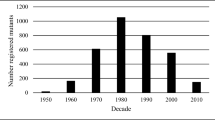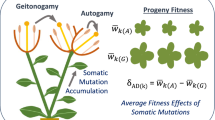Summary
Many long-lived plant taxa are characterized by relatively high genetic load levels. This genetic load is manifested as the proportion of offspring that are physiologically handicapped to various degrees. It is proposed that the majority of this load is mutational load and is a consequence of the higher per generation mutation rates that occur in long-lived plants. Higher per generation mutation rates are a result of the chemostat-like accumulation of mutations in the apical initials as the plant grows. Genetic load, therefore, is a function of the postzygotic accumulation of mutations as well as mutations inherited from previous generations.
Similar content being viewed by others
References
Bhatia CR, Joshua DC, Mathews H (1985) Somaclonal variation: a genetic interpretation based on the rates of spontaneous chromosomal aberrations and mutations. In: Govil CM, Kumar V (eds) Trends in plant research. Bishen Singh Mahendra Pal Singh, Dehra Dun, India, pp 317–326
Bishir J, Namkoong G (1987) Unsound seeds in conifers: estimation of numbers of lethal alleles and of magnitudes of effects associated with the maternal parent. Silvae Genet 36: 180–185
Brandham PE (1976) The frequency of spontaneous structural change. In: Jones K, Brandham PE (eds) Current chromosome research. Elsevier/North Holland Biomedical Press, Amsterdam, pp 77–87
Brandham PE (1983) Evolution in a stable chromosome system. In: Brandham PE, Bennett MD (eds) Kew chromosome conference, vol II. George Allen and Unwin, London, pp 251–260
Caspari E (1948) Cytoplasmic inheritance. In: Demerec M (ed) Advances in genetics, vol II. Academic Press, New York, pp 1–66
Crow JF (1958) Some possibilities for measuring selection intensities in man. Hum Biol 30: 1–13
Crow JF, Kimura M (1970) An introduction to population genetics theory. Harper and Row, New York
Crumpacker DW (1967) Genetic loads in maize (Zea mays L.) and other cross-fertilized plants and animals. Evol Biol 1: 306–424
D'Amato F, Hoffmann-Ostenhof O (1956) Metabolism and spontaneous mutations in plants. Adv Genet 3: 1–28
Davidson D (1960) Meristem initial cells in irradiated roots of Vicia faba. Ann Bot 24: 287–295
Dobzhansky T (1955) A review of some fundamental concepts and problems of population genetics. Cold Spring Harbor Symp Quant Biol 20: 1–15
Dobzhansky T (1970) Genetics of the evolutionary process. Columbia University Press, New York
Eldridge KG, Griffin AR (1983) Selfing effects in Eucalyptus regnans. Silvae Genet 32: 216–221
Eriksson G, Schelander B, Akebrand V (1973) Inbreeding depression in an old experimental plantation of Picea abies. Hereditas 73: 185–194
Fowler DP (1965a) Effects of inbreeding in red pine, Pinus resinosa Ait. II. Pollination studies. Silvae Genet 14: 12–23
Fowler DP (1965b) Effects of inbreeding in red pine, Pinus resinosa Ait. III. Factors affecting natural selfing. Silvae Genet 14: 37–45
Fowler DP (1965c) Effects of inbreeding in red pine, Pinus resinosa Ait. IV. Comparison with other northeastern Pinus species. Silvae Genet 14: 76–81
Frankel R (1983) Heterosis. Springer, Berlin Heidelberg New York
Giles N (1940) Spontaneous chromosome aberrations in Tradescantia. Genetics 25: 69–87
Griffin AR, Moran GF, Fripp YJ (1987) Preferential outcrossing in Eucalyptus regnans F. Muell. Aust J Biol 35 (in press)
Grun P (1976) Cytoplasmic genetics and evolution. Columbia University Press, New York
Haldane JBS (1937) The effect of variation on fitness. Am Nat 71: 337–349
Jacquard A (1974) The genetic structure of populations. Springer, Berlin Heidelberg New York
Jaynes RA (1968) Self incompatibility and inbreeding depression in three laurel (Kalmia) species. Proc Am Soc Hort Sci 93: 618–622
Jaynes RA (1969) Chromosome counts of Kalmia species and revaluation of K. polifolia var. microphylla. Rhodora 71: 280–284
Jinks JL (1983) Biometrical genetics of heterosis. In: Frankel R (ed) Heterosis. Springer, Berlin Heidelberg New York, pp 1–46
Jones DF (1940) Nuclear changes affecting growth. Am J Bot 27: 149–155
Jones DF (1941) Somatic segregation. Bot Rev 7: 291–307
Jones DF (1952) Plasmagenes and chromogenes in heterosis. In: Gowen JW (ed) Heterosis. Iowa State College Press, Ames, Iowa, pp 224–235
Jones DF, Stinson HT Jr, Khoo U (1957) Transmissible variations in the cytoplasm within species of higher plants. Proc Natl Acad Sci 43: 598–602
Jørgensen JH, Jensen HP (1986) The spontaneous chlorophyll mutation frequency in barley. Hereditas 105: 71–72
Klekowski EJ Jr (1984) Mutational load in clonal plants: a study of two fern species. Evolution 38: 417–426
Klekowski EJ Jr (1988a) Mutation, developmental selection, and plant evolution. Columbia University Press, New York
Klekowski EJ Jr (1988b) Progressive cross and self-sterility associated with aging in fern clones and perhaps other plants. Heredity (in press)
Klekowski EJ Jr (1988c) Mechanisms that maintain the genetic integrity of plants. In: Greuter W, Zimmer B (eds) Proceedings of the XIV International Botanical Congress. Koeltz, Königstein/Taunus (in press)
Klekowski EJ Jr, Kazarinova-Fukshansky N, Fukshansky L (1988) Patterns of plant ontogeny that may influence genomic stasis. Am J Bot (in press)
Kondrashov AS (1982) Selection against harmful mutations in large sexual and asexual populations. Genet Res 40: 325–332
Kondrashov AS (1984) Deleterious mutations as an evolutionary factor. 1. The advantage of recombination. Genet Res 44: 199–217
Koski V (1973) On self-pollination, genetic load, and subsequent inbreeding in some conifers. Commun Inst For Fenn 78.10: 1–40
Levin DA (1984) Inbreeding depression and proximity-dependent crossing success in Phlox drummondii. Evolution 38: 116–127
Lewontin RC (1974) The genetic basis of evolutionary change. Columbia University Press, New York
Libby WJ, McCutchan BG, Millar CI (1981) Inbreeding depression in selfs of redwood. Silvae Genet 30: 15–25
Masuyama S (1979) Reproductive biology of the fern Phegopteris decursive-pinnata I. The dissimilar mating systems of diploids and tetraploids. Bot Mag Tokyo 92: 275–289
Mettler LE, Gregg TG, Schaffer HE (1988) Population genetics and evolution, 2nd edn. Prentice Hall, Englewood Cliffs, New Jersey
Morton NE, Crow JF, Muller HJ (1956) An estimate of the mutational damage in man from data on consanguineous marriages. Proc Nad Acad Sci USA 42: 855–863
Muller HJ (1950) Our load of mutations. Am J Hum Genet 2: 111–176
Namkoong G, Bishir J (1987) The frequency of lethal alleles in forest tree populations. Evolution 41: 1123–1127
Novick A, Szilard L (1950) Experiments with the chemostat on spontaneous mutations of bacteria. Proc Natl Acad Sci USA 36: 708–719
Novick A, Szilard L (1951) Genetic mechanisms in bacteria and bacterial viruses. I. Experiments on spontaneous and chemically induced mutations of bacteria growing in the chemostat. Cold Spring Harb Symp Quant Biol 16: 337–343
Ohnishi O (1982) Population genetics of cultivated common buckwheat, Fagopyrum esculentum Moench. I. Frequency of chlorophyll-deficient mutants in Japanese populations. Jpn J Genet 57: 632–639
Russell WA, Sprague GF, Penny LH (1963) Mutations affecting quantitative traits in long-time inbred lines of maize. Crop Sci 3: 175–178
Rutishauser A, La Cour LF (1956) Spontaneous chromosome breakage in endosperm. Nature 177: 324–325
Sankaranarayanan K (1979) The role of non-disjunction in aneuploidy in man. An overview. Mutat Res 61: 1–28
Schlarbaum SE, Tsuchiya T (1984) A chromosome study of coast redwood, Sequoia sempervirens [(D. Don) Endl.]. Silvae Genet 33: 56–62
Schneller JJ (1979) Biosystematic investigations on the lady fern (Athyrium filix-femina). Pl Syst Evol 132: 255–277
Shull GH (1952) Beginnings of the heterosis concept. In: Gowen JW (ed) Heterosis. Iowa State College Press, Ames, Iowa, pp 14–48
Sorensen F (1969) Embryonic genetic load in coastal Douglasfir, Pseudotsuga Menziesii var. Menziesii. Am Nat 103: 389–398
Sprague GF, Russell WA, Penny LH (1960) Mutations affecting quantitative traits in the selfed progeny of doubled monoploid maize stocks. Genetics 45: 855–866
Srivastava HK (1981) Intergenomic interaction, heterosis, and improvement of crop yield. Adv Agron 34: 117–195
Stadler LJ (1942) Some observations on gene variability and spontaneous mutation. The Spragg Memorial Lectures on Plant Breeding (3rd series). Michigan State College, East Lansing
Stevens JP, Bougourd SM (1988) Inbreeding depression and the outcrossing rate in natural populations of Allium schoenoprasum L. (wild chives). Heredity 60: 257–261
US Department of Agriculture, Forest Service (1974) Seeds of woody plants in the United States. USDA Agricultural Handbook No. 450, Washington, D. C.
Wallace B (1970) Genetic load. Prentice-Hall, Englewood Cliffs, New Jersey
Wallace B (1981) Basic population genetics. Columbia University Press, New York
Warne TR, Lloyd RM (1981) Inbreeding and homozygosity in the fern, Ceratopteris pteridoides (Hooker) Hieronymus (Parkeriaceae). Bot J Linn Soc 83: 1–13
Wilby AS, Parker JS (1988) Mendelian and non-Mendelian insheritance of newly-arisen chromosome rearrangements. Heredity 60: 263–268
Wilcox MD (1983) Inbreeding depression and genetic variances estimated from self and cross-pollinated families of Pinus radiata. Silvae Genet 32: 89–95
Ying CC (1978) Performance of white spruce [Picea glauca (Moench) Voss] progenies after selfing. Silvae Genet 27: 214–215
Zirkle C (1952) Early ideas on inbreeding and crossbreeding. In: Gowen JW (ed) Heterosis. Iowa State College Press, Ames Iowa, pp 1–13
Author information
Authors and Affiliations
Rights and permissions
About this article
Cite this article
Klekowski, E.J. Genetic load and its causes in long-lived plants. Trees 2, 195–203 (1988). https://doi.org/10.1007/BF00202374
Received:
Issue Date:
DOI: https://doi.org/10.1007/BF00202374




